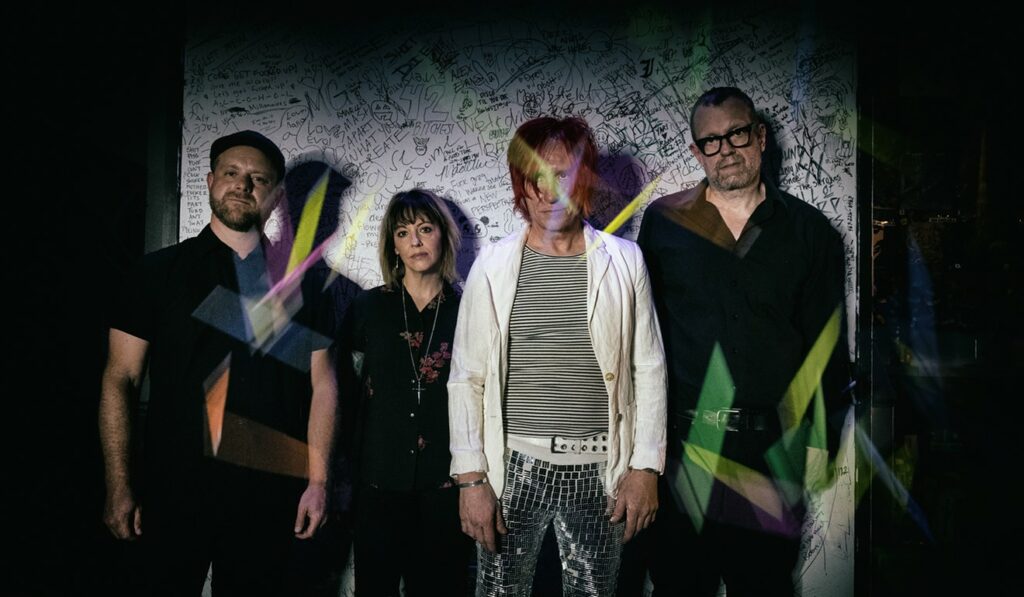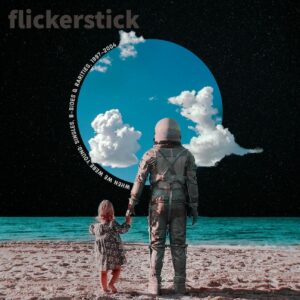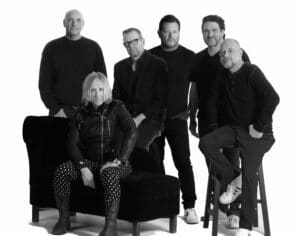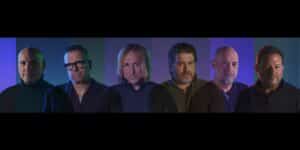Originally published July 14, 2022
https://www.dallasobserver.com/music/flickerstick-band-is-back-by-popular-demand-14092508
From major label success to a slow burnout, the Flickerstick story is one of the wildest in Dallas’ rock history, and one that’s entirely emblematic of the early aughts: It involves 9/11, Incubus, reality competition shows and the onset of social media.
At the dawn of the millennium, Deep Ellum bred a thriving music scene that produced a plethora of critically acclaimed bands such as Eisley, Black Tie Dynasty and Flickerstick.
The five-piece Flickerstick band experienced a blitzkrieg of success in the early 2000s after winning a reality TV show, signing a major label record contract and touring the U.S. a few times over.
Although the group officially disbanded in 2009 after suffering the extremes of the music world’s bipolarity, their fans never forgot them and worked relentlessly to get the band reunited. After the better part of a decade, a local label, a fan-made Facebook group and a good friend named Beau made Flickerstick’s unlikely reunion a reality.
After a 13-year hiatus, Flickerstick was finally back on stage together, performing at The House of Blues. The Dallas darling rock band performed back-to-back shows on June 25 and 26. The reunion shows included all five members of the original lineup, plus two new additions to the band. Both nights sold out.
Fans never forgot about Flickerstick and lobbied until the band got back together.
The Beginning
In 1994, singer Brandin Lea and guitarist Cory Kreig met at Southwest High School in Fort Worth and struck up a friendship that became the foundation of Flickerstick. A freshman, Lea had transferred to Southwest from a private school, and the boisterous Kreig was one of the first people he met.
“Cory and I met in ninth grade,” Lea remembers. “This kid came in late to class and everyone knew him. He sat down next to me, and looked straight at me and says, ‘Who the fuck is this guy?’ ”
The pair eventually bonded over their mutual love for alternative music. Lea had already started playing in a band, and Kreig liked to watch their rehearsals. Although Kreig later transferred to another school, the pair’s friendship remained after graduation. Lea taught Kreig how to play guitar.
“We were 18 about to turn 19, and on April 9, 1994, Cory came to my house with a guitar in his hand. That was the day we found out Kurt Cobain had died,” Lea says. “He said, ‘Hey man, can you teach me how to play this thing?’ He was oddly knowledgeable for not knowing how to play anything. He played guitar for all of three months, and then in ’95 found himself in the band at 19.”
The pair started writing and rehearsing with Lea’s younger brother Fletcher on bass and with childhood friend Jeff Lowe on drums. The fledgling group first performed at open mic nights around Fort Worth and Denton, slowly edging its way toward Deep Ellum’s stages.
“Our goal in life was to play Trees, not to finish college, buy a house, get married,” Lea says. “We just wanted to play Trees. A Wednesday night slot or anything; that’s all we wanted.”
The young musicians were fans of North Texas bands Toadies and Tripping Daisy and regularly made the drive to Dallas to watch them perform.
“Cory and I were watching Tripping Daisy play Trees one night, and Tim wasn’t like any frontman I had ever seen at the time,” Lea says. “That guy was on fire! When I saw Tim DeLaughter, I said, ‘Hey, I can do that.’”
While those bands were racking up cash, selling out large clubs and signing record contracts, Flickerstick was in the midst of a journey that would repeat their local idols’ trajectory.
“We got our first Dallas show a year later at the Orbit Room, and then after the show a guy named Dominic approached us about his band playing Curtain Club,” Lea says. “I’d never met a guy like Dominic before. The guy was an animal. He already lived in Deep Ellum and knew everybody. He declared himself Flickerstick’s new drummer.”
Dominic Weir had his own practice studio/apartment, which he offered up for the group’s use. He saw something in the band’s early songwriting and performance style and knew they were destined for success.
“I had another band at the time, and when I saw Flickerstick they were awesome,” Weir remembers of his first encounter with the band. “I talked to them afterwards and said, ‘I need to be in this band.’ I brought them out to Deep Ellum, and we hit all the bars. I was the Deep Ellum terrorist at the time — try and hang with me and you’re gonna puke.”
When Weir joined, the band started drawing bigger crowds. After a particularly packed Curtain Club show, the booking agent for Trees reached out to Flickerstick to open for Grand Street Cryers, fulfilling Lea and Kreig’s shared early dream.
Soon after, guitarist Rex Ewing, also known as “El Dangeroso” because of his punk rock-inspired stage antics, joined the roster, jolting Flickerstick into headlining shows all across North Texas.
“Cory and I worked together, and I had been out of bands at that point for about six years,” Ewing says. “When I heard them, I was like, man, I need to weasel my way into this. Luckily, they were lazy about trying people out. Also, Brandin wanted to just be a frontman.”
While other bands of the 2000s like The Strokes and The White Stripes were rebranding garage rock, Flickerstick was clearly influenced by British bands of the ages. Their space rock/pop sound relied heavily on special guitar effects, simple drum beats and the soaring vocals of Lea, putting them in a unique classification as a neo-psychedelic rock band.
The band signed with manager Paul Bassman and performed a label showcase at New York’s CBGB club before recording and releasing its first offering, Welcoming Home the Astronauts, in 2000. The album, produced by Todd and Toby Pipes of Deep Blue Something, quickly became a local classic — the production value trumped that of the majority of local releases — and it gathered substantial industry attention.
Shortly after the release, Flickerstick found a national spotlight on a VH1 reality TV show called Bands on the Run. The show had a loose “battle of the bands” premise. Four bands fought for a prize that included the opportunity to play in front of industry executives, a chance to film a music video to be played on the network and $100,000. It ran for one season and showed each band’s hustle as they independently produced, promoted and performed in various cities. Flickerstick ultimately won.
Beyond the band’s music, the series also showcased the young group’s vintage fashion sense, excessive partying and laddish ways which, of course, made for great reality television. Young groups all around North Texas were seen on stages sporting Lea’s signature white belt, Kreig’s Western shirts and Weir’s maroon leather jackets.
After claiming the grand prize, the band fielded offers from major labels in a bidding war that Epic/Sony ultimately won.
“A great misconception about the band was that we were signed to Sony because we won the show,” Lea says. “It was actually difficult to get labels to pay attention to us because of the show.”
The cameras had, at times, caught the band mid-fight, and even more times mid-party. They might not have seemed the best bet, but they won the show because of their musical abilities. On the other hand, the popularity of the show helped them build a national following, making it easier to break out.
“A lot of labels were turned off by the fact we were in a reality show,” Kreig says. “Remember at that same exact time shows like Making the Band were on TV, and it gave the impression we were formed for the show. It was a credibility thing. In a few album reviews in magazines they would barely talk about our music and just make fun of us for being on TV. Some of the labels just kind of blew us off as a novelty act. It wasn’t until we started selling out big venues and getting radio play in several markets that labels started to take notice.”
Flickerstick was rising in 2001, but after 9/11 music labels starting dropping bands.
The Ride
On Sept. 10, 2001, a few months after their win was televised, Flickerstick found themselves on tour in New York City, riding a new wave of success. They invited Dallas legends Doosu along on the ride as opening support. Flickerstick had been invited to several high-profile parties, but Lea was sick with strep throat at the hotel and his band members ran into label mates Incubus while out on the town. Things got a little out of hand at one party. The story goes that one of Flickerstick’s members was at odds with one of the members of Incubus and took a swing. After the dust-up, the band hastily made its way back to the hotel and to sober Lea’s surprise, a highly inebriated Kreig was hand-delivered to his room like the very best of New York room service.
The next day, Flickerstick was scheduled to play a sold-out show at Irving Plaza for a group of media bigwigs who oversaw bookings for all the late-night TV shows including Saturday Night Live. Maroon 5 was also added to the bill at the last minute as an opener. On Sept. 11, Lea woke up to Kreig passed out in the bathroom. While getting out of bed, sore from a steroid shot administered to him the night before, Lea heard a loud screeching from above.
“I’m sitting on the bed, and I can hear what sounds like a train and it gets so loud, and then everything shakes,” Lea remembers. “I turn on the news and then the phone rings, and it’s our manager Paul Bassman a few floors below in the hotel telling us what he thinks has happened. He thought maybe a pilot missed La Guardia and hit one of the towers. I got up, grabbed the two sticks to open the curtains and I heard the noise again. I look up and can see a plane, and it totally slams into the second building, and I hear Paul scream and I drop the phone. I immediately woke Cory up, and he sobered up as soon as he saw the TV.”
The band was staying just a few blocks from the Twin Towers, and the members of Doosu were a mere three blocks away from the impact. They all still recall the panic, chaos and destruction that unfolded around them as they sat at the hotel bar waiting for confirmation that everyone was OK and that their showcase was canceled. Cellphone service was next to impossible, but the group finally got a call from Toby Pipes, guitarist of Deep Blue Something, offering his help to contact their families back in Texas.
“Everybody wrote down two numbers, and Toby called home to let our friends and families know that we were OK,” Lea says. “It was impossible to get out of New York, so we stayed put and ultimately decided we would continue the tour. Doosu stayed on with us and slept in our bus that night because they were evacuated and had to leave everything they owned at the hotel.”
Todd Harwell, Doosu’s drummer and current Flickerstick member, can still vividly recall the events of those days.
“I parked the Doosu van around Irving Plaza the night before and walked all the way down to the Cosmopolitan in Manhattan where we were staying,” he says. “I got back to the room around 4:45 a.m. and fell asleep. When the first plane hit, it sounded like a really bad car accident. I saw smoke and went downstairs to Starbucks to see what was happening. When the second plane hit, I felt a serious wall of heat three blocks away from the Trade Center and I just ran. I thankfully ran into tour manager Sean Bailey, and we met up with everyone else six or so hours later. It was bizarre.”
Their next show was at Asbury Park, New Jersey. Flickerstick and Doosu delivered emotional sets, riddled with breakdowns from the bands and audience alike. They finished the rest of the tour and headed home, waiting for a call from their record label.
A few weeks later, Flickerstick got the long-awaited call. The attacks on 9/11 caused a seismic shift in the music industry, and Epic/Sony had decided to delay the release of their next scheduled single, “Coke,” and scrapped the budget for the accompanying music video.
“When we started hearing about bands getting dropped, one half of me thought things were going to be OK, the other part of me knew it had just died,” Lea says of that time in the music industry. “I got a call from our manager that the label had decided to keep us on the roster, but that our A&R guy had been laid off. It sent us all into a spiral of epic proportions.”
The Reunion
Within a couple of years, the band would find itself without the support of a major label. Flickerstick left Epic/Sony and was eventually able to get back the rights to its first record. The band also shuffled through lineup changes as Weir was let go and Kreig left the group after a rocky recording session for the next album. Harwell and Tim Locke took their places in the band. Flickerstick released its second studio album, Tarantula, in 2004 on Idol Records and spent years on grueling tours in support of the album. After several more live releases, each member embarked on separate journeys and careers. The band called it quits in January 2009.
Years later, as Generation Xers discovered the joys of Facebook in the early 2010s, local politician Chris Putnam and fan Al Zito decided to start a Facebook group called “The Flickerstick Social Media Experiment” (now Flickerstick Official) to help build a community around the music in the hope that, with any luck, it might wrangle the group back to the stage.
“I was in a hotel room in Germany, flying around everywhere for work, drinking bourbon and listening to Flickerstick,” Putnam says. “Years after they split up, I was still passionate about their music. No other band brought that kind of energy to their live shows. I started the page to try and encourage the band to get back together and thought, ‘This is going to be fun.’”
Eventually, several Flickerstick band members joined the Facebook group and interacted with fans for the better part of a decade. People started joining by the hundreds to share pictures, stories and pleas for Flickerstick to play once more. In 2021, with Flickerstick nostalgia reaching a 20-year high, a new label called DFW Legacy Series, run by Travis Hill and G.I. Sanders, partnered with the group to re-release Flickerstick’s debut album on vinyl. After selling through the pressing of Welcoming Home the Astronauts in a matter of just a few days, a reunion began to seem more likely. With the help of one musician friend, fan and now full-time Flickerstick member Beau Wagener, conversations among the old members started mending old wounds. They also started becoming aware of their legacy.
“Through the DFW Legacy Series we were all texting,” Wagener says. “G.I. wanted Flickerstick. I hit Cory up and he agreed to do it, after Doosu’s Aqua Vita [limited-edition vinyl] album had been so successful. We really started talking a lot, growing our friendship, and then he started sending me songs. Then he texted me, ‘Do you want to be in the band?’ I was shocked.”
Perhaps even more shocking, all original members agreed to return for the long-awaited reunion. They also decided that Flickerstick would continue past the reunion, with Wagner replacing Kreig and his former bandmate, Fatima Thomas, of The Crash that Took Me, filling in for Fletcher Lea on bass.
“When Beau called me and asked me to play, I was blown away,” Thomas says. “It was no question for me. DFW has such a great music scene because it’s really like a big family supporting each other.”
The last piece of the Flickerstick puzzle was complete. Lea, Kreig and Ewing came together to iron out any kinks and settle their differences. Kreig invited Ewing to a long lunch after Weir had agreed to fly down from New York for the reunion.
“Everyone was under the impression that Rex was out; I still texted him from time to time, though,” Kreig says. “When we decided to do a reunion, I worked off the assumption Rex wouldn’t be involved. I finally broke down and just said, ‘Hey man, I don’t want to offend you, but would you be down for a reunion?’ The fact that he said he was open to it, I was like, Oh shit!”
Lea and Kreig shared a few realizations.
“Cory and I were the guys who always agreed on everything, but if we butted heads it was terrible,” Lea says. “He always had a better business sense, and it was really hard to have two leaders in one band. What I learned was, I was wrong about a lot of things.”
One day after House of Blues announced Flickerstick’s 2022 reunion show, tickets sold out. A second date was added. It also sold out. The Flickerstick Social Media Experiment worked so well that once again, Flickerstick can envision a bright future.
For superfan Putnam, seeing the band come together was well worth the wait.
“That night I had a smile from ear to ear,” he says. “I cannot believe this actually happened, and it was this big. It was surreal.”
With all new and original band members in agreement, some will stay the course with Lea, including original guitarist Ewing, and others will gracefully bow out, contributing in new ways. With plans to write, release music and tour regularly once again, Flickerstick is officially back. And they’re already bigger than they’d once dreamed.
“Cory and I were on the phone trying to decide where we wanted to have the shows.” Lea says. “We were throwing around ideas and then Trees came up. Cory stopped and said, ‘No, we can’t, it’s too small.’ I stopped him right there and said, ‘Hold it. Go on a journey with me, man: We are 47 years old, and when we were 20, our only goal in life was to play Trees.’ It was a moment.”





